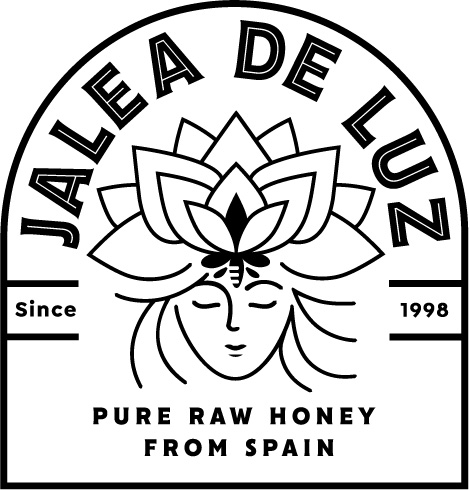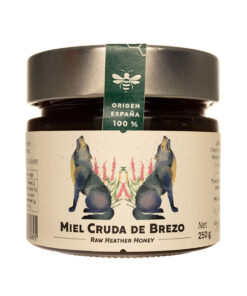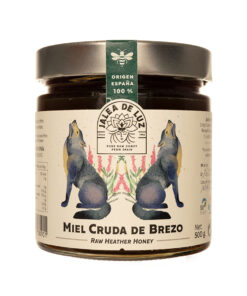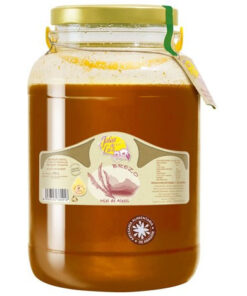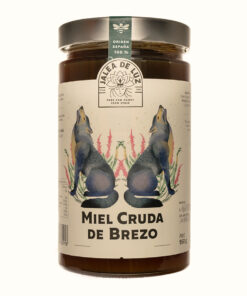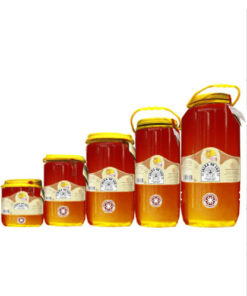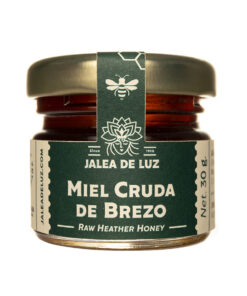Heather honey
Origin : Spain and other areas of the Iberian Peninsula.Representative species : Heather ( Calluna vulgaris ).
Main floral composition : varieties of Heather (Calluna vulgaris), Chestnut (Castanea sativa), wild fruit, Hawthorn (Crataegus oxycantha), Bush (Rubus sp.), Brooms (Cytisus multiflorus), brooms (Retama sphaerocarpa), Wild Rose (canine Rose), Jara (Cistus ladanifer), Canthus (Lavandula stoechas), thyme (Thymus vulgaris) and varied native wild Flora.
Production period : late summer and early autumn.
Color : dark amber with reddish shades to intense mahogany.
Flavor : sweet and intense, with notes between slightly bitter, sour and salty.
Aroma : it enjoys intense and lasting atavistic essences, with marked floral components.
Peculiarities: raw honey, pure, not homogenized, not filtered, without added sugars.
Conservation : keep dry, semi-dark and cool.
** In its natural process, honey crystallizes and hardens according to various parameters (temperature, floral origin, etc.
Characteristics of heather honey
It has dark amber color with shades of red tone and can acquire deep caobas nuances if it is enriched with myelates. Its taste is sweet very intense, with hodgepodge of notes that vary between bitter, balance and acid.The aroma of natural heather honey enjoys powerful and durable atavistic essences, with marked floral components.
It has medium crystallization according to polymic composition, highlighting its high viscosity and high density.
Honey rich in vitamins (vitamin B and C), minerals (phosphorus, calcium, magnesium), carbohydrates, sugars (glucose and fructose) and proteins (in the form of enzymes and amino acids).
Excellencies of heather honey
Like our entire range of honeys and derivatives (propolis, royal jelly, pollen,..), natural select heather honey collected by our bees and stored in the hive, thus meets all the requirements of an excellent natural product:* Unfiltered: to achieve an excellent natural product, we never filter our honey, because in this way we retain all the natural qualities of origin.
* Free of added sugars: our honey is pure, just as the bee produced it in the hive. It contains only sugars typical of unprocessed natural honey.
* Raw: never subjected to methods of overheating (more than 40 degrees) or pasteurization, managing to preserve intact all its vitamins, nutrients and enzymes. We also maintain, through this natural process, all its taste and olfactory qualities.
* Pure: the bees release pollen and nectar of flowers, and secretions of sucking plants and insects that provides the native flora of each natural region, then proceeding to its transformation and storage in the cells of the hive; later it is collected and packaged directly through a process in which no factors outside those that nature itself provides intervene.
* Non-homogenized: to preserve all the attributes of a pure product, we never mix natural honeydew from different geographical or floral origins, because our permanent goal is to maintain the essence and purity from its origin to the palate of the final consumer.
Usage tips
Natural Heather honeys collected by our bees have unique characteristics, so it is advisable to take them directly, tasting them inside the mouth as long as possible before ingesting them. To make them more manageable in those cases that are preferred diluted, it is recommended at most, warm the "bain-marie" to temperature that never exceeds 40 º to avoid the loss of qualities.Conservation tips
Keep in a dry, semi-dark and cool place to keep intact in a natural way all its attributes.Where does it come from?
This exquisite and traditional natural honey, is produced by bees, as a result of libation by extracting pollen and nectar from the flowers of species such as Heather (Calluna vulgaris), Chestnut (Castanea sativa), wild fruit, Hawthorn (Crataegus oxycantha), Bush (Rubus sp.), brooms (Cytisus multiflorus), brooms (Retama sphaerocarpa), Wild Rose (canine Rose), jara (Cistus ladanifer), canthus (Lavandula stoechas), thyme (Thymus vulgaris), varied native wild flora, and late myelates come mostly from the secretions of trees and some sucking insects located in areas of zamorano forest.Heather plants form a shrub of medium or small size, highly branched into dark brownish red stalks, with tiny opposite leaves, and numerous pink flowers grouped in Terminal clusters, which appear from spring to early autumn and subtly attract the pecoreador bees; its fruit is a globose capsule with large seeds.
Heather honey, etymology and History
The common word “Heather“, comes from the Celtic” vroiceus“, through the Hispanic/Latin” broccius“, although it is also given Indo-European roots (”wer – 3 =circle, Bend“), leading to the Latin verb “ vertiare-verteré “with similar meaning, which gave rise to the verb”brezar".The generic Calluna has its origin in the Greek word "sweep“, since this plant was used to make brooms; the specific name” vulgaris = common" comes from Latin . Another possible origin is the Greek word "kallýno = clean, beautify".
The plants of heather are originally from Europe (widespread in northern countries such as Scotland, Ireland, Sweden, Norway,...), north Africa and America, where it thrives in poor soils, and acidic as bogs, moors and heathland; its evolution was based on the colonization of the western Mediterranean from the east of Africa and Arabia, in a time set between the periods of the Upper Miocene and Upper Pleistocene. It has had an important place throughout history in various cultures because of its many daily uses: it was used to strengthen and isolate the roofs of houses, such as cattle beds, fuel production, manufacture of baskets and ropes, and as we mentioned before, to make brooms. Natural heather honey harvested in the traditional way therefore had multiple applications.
Recipes with heather honey
tropical incoming with heather honeyFirst, cut into tacos half pineapple and 300 grs of melon Gaul; then grate a quarter of cucumber, a carrot and a quarter of green pepper.
We use the half emptied pineapple and place in the background a base of leaves of Tudela buds.
We bring a layer of peeled prawns (400 grs) and cut into two halves, a dozen cherry tomatoes, a small piece of tofu and another of fresh defatted cheese cut into small dice.
In a mortar, we prepare a vinaigrette sauce with two tablespoons of virgin olive oil, a pinch of sea salt, a tablespoon of natural honey tea of handmade breezes collected by our bees, a tablespoon of balsamic vinegar of Modena and another pinch of crushed basil, we mix everything and macerate.
Add the rest of natural foods that we had previously cut into tacos and sprinkle with vinaigrette sauce.
We keep it in the fridge, and that's it!!!! , natural recipe with a lot of flavor and highly recommended by way of incoming appeal.
